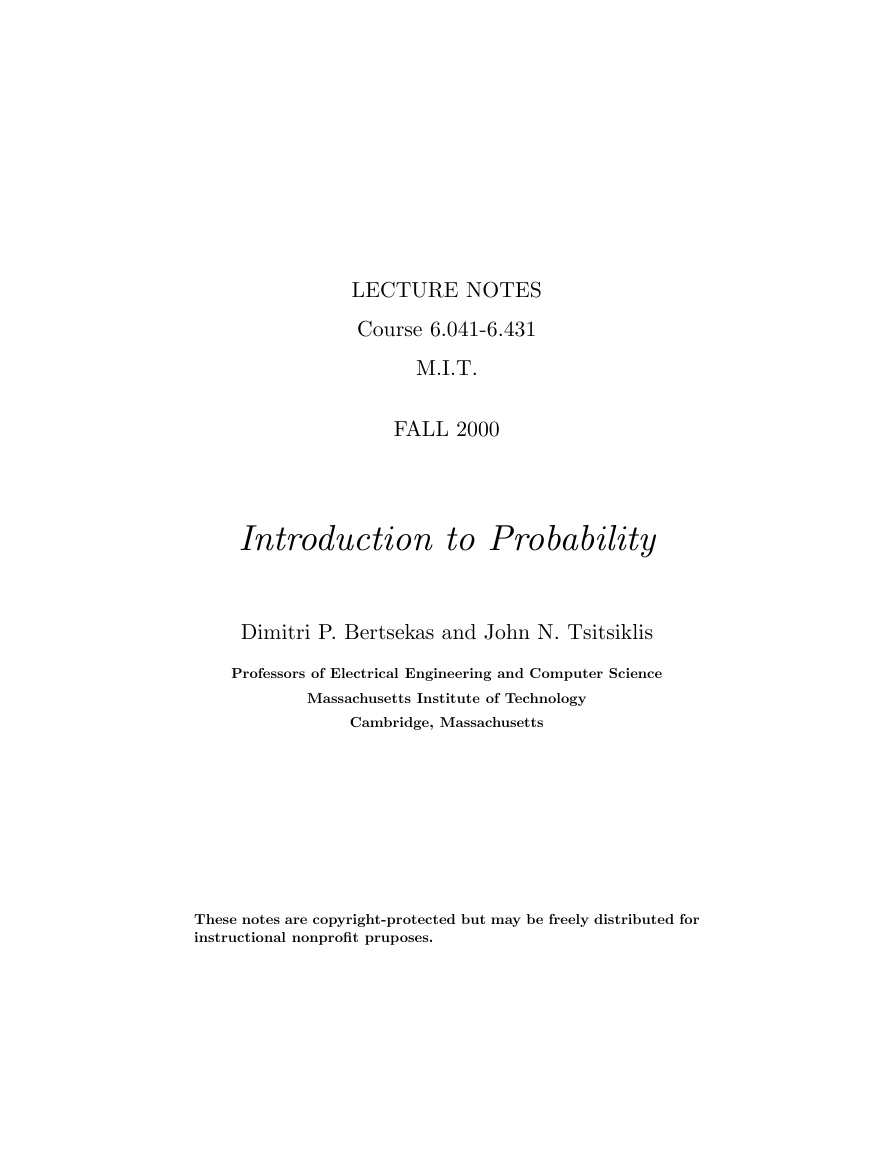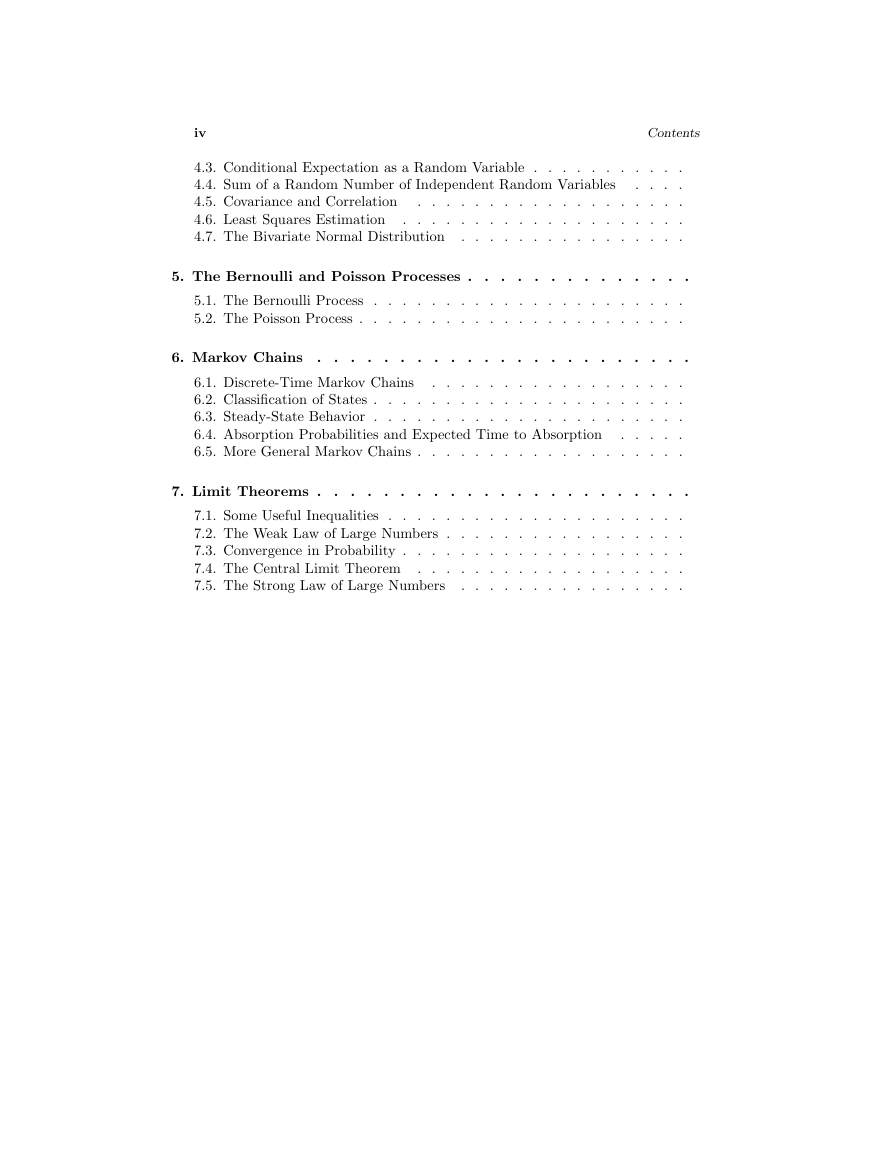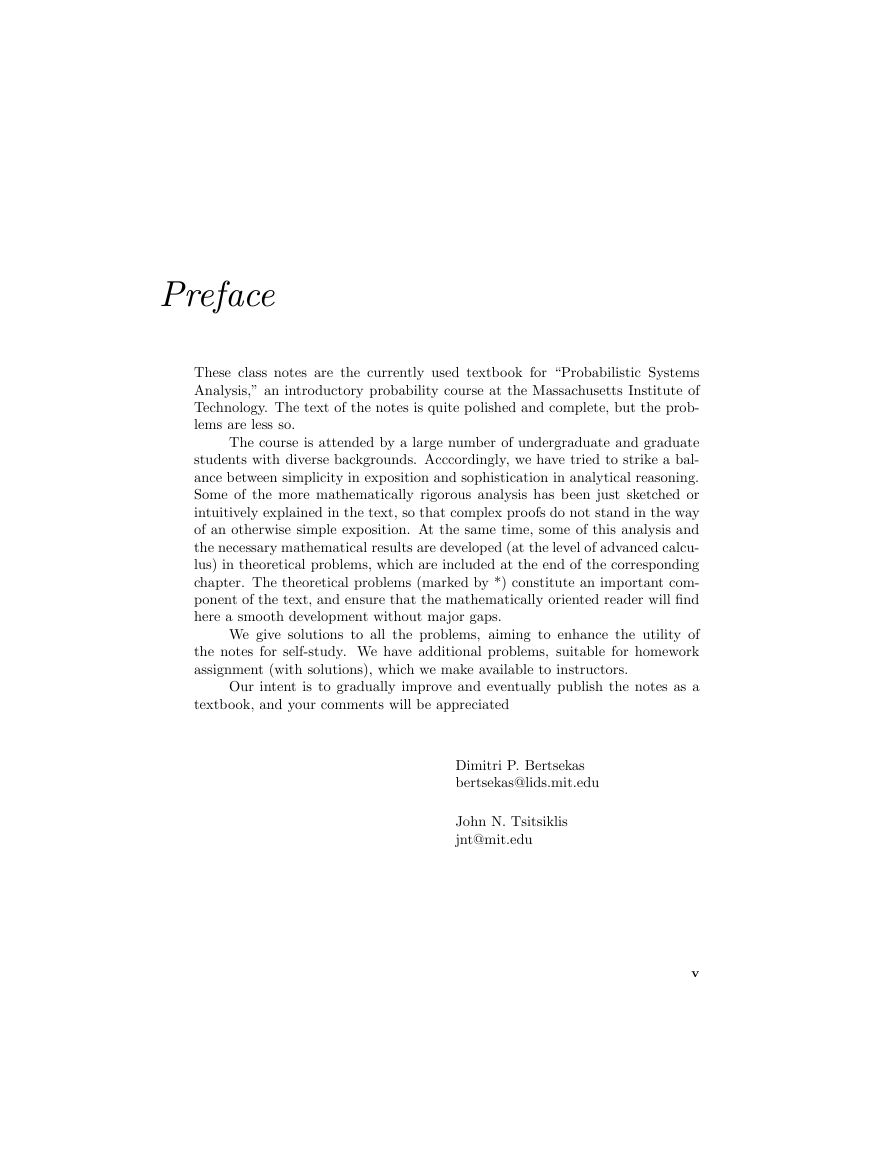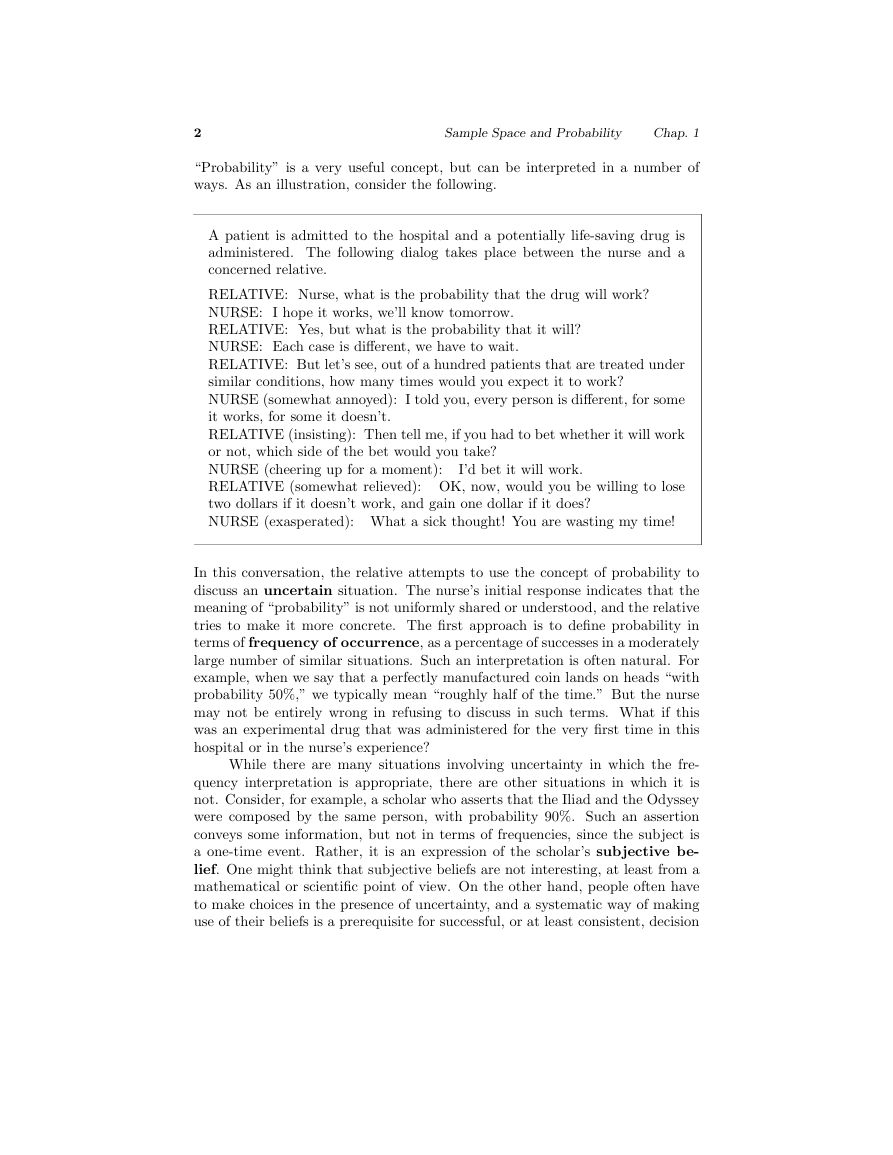LECTURENOTESCourse6.041-6.431M.I.T.FALL2000IntroductiontoProbabilityDimitriP.BertsekasandJohnN.TsitsiklisProfessorsofElectricalEngineeringandComputerScienceMassachusettsInstituteofTechnologyCambridge,MassachusettsThesenotesarecopyright-protectedbutmaybefreelydistributedforinstructionalnonpro�tpruposes.�
�
Contents1.SampleSpaceandProbability................1.1.Sets..............................1.2.ProbabilisticModels.......................1.3.ConditionalProbability.....................1.4.Independence..........................1.5.TotalProbabilityTheoremandBayes’Rule............1.6.Counting...........................1.7.SummaryandDiscussion....................2.DiscreteRandomVariables.................2.1.BasicConcepts.........................2.2.ProbabilityMassFunctions...................2.3.FunctionsofRandomVariables..................2.4.Expectation,Mean,andVariance.................2.5.JointPMFsofMultipleRandomVariables.............2.6.Conditioning..........................2.7.Independence..........................2.8.SummaryandDiscussion....................3.GeneralRandomVariables.................3.1.ContinuousRandomVariablesandPDFs.............3.2.CumulativeDistributionFunctions................3.3.NormalRandomVariables....................3.4.ConditioningonanEvent....................3.5.MultipleContinuousRandomVariables..............3.6.DerivedDistributions......................3.7.SummaryandDiscussion....................4.FurtherTopicsonRandomVariablesandExpectations......4.1.Transforms...........................4.2.SumsofIndependentRandomVariables-Convolutions.......iii�
ivContents4.3.ConditionalExpectationasaRandomVariable...........4.4.SumofaRandomNumberofIndependentRandomVariables....4.5.CovarianceandCorrelation...................4.6.LeastSquaresEstimation....................4.7.TheBivariateNormalDistribution................5.TheBernoulliandPoissonProcesses..............5.1.TheBernoulliProcess......................5.2.ThePoissonProcess.......................6.MarkovChains.......................6.1.Discrete-TimeMarkovChains..................6.2.Classi�cationofStates......................6.3.Steady-StateBehavior......................6.4.AbsorptionProbabilitiesandExpectedTimetoAbsorption.....6.5.MoreGeneralMarkovChains...................7.LimitTheorems.......................7.1.SomeUsefulInequalities.....................7.2.TheWeakLawofLargeNumbers.................7.3.ConvergenceinProbability....................7.4.TheCentralLimitTheorem...................7.5.TheStrongLawofLargeNumbers................�
PrefaceTheseclassnotesarethecurrentlyusedtextbookfor“ProbabilisticSystemsAnalysis,”anintroductoryprobabilitycourseattheMassachusettsInstituteofTechnology.Thetextofthenotesisquitepolishedandcomplete,buttheprob-lemsarelessso.Thecourseisattendedbyalargenumberofundergraduateandgraduatestudentswithdiversebackgrounds.Acccordingly,wehavetriedtostrikeabal-ancebetweensimplicityinexpositionandsophisticationinanalyticalreasoning.Someofthemoremathematicallyrigorousanalysishasbeenjustsketchedorintuitivelyexplainedinthetext,sothatcomplexproofsdonotstandinthewayofanotherwisesimpleexposition.Atthesametime,someofthisanalysisandthenecessarymathematicalresultsaredeveloped(atthelevelofadvancedcalcu-lus)intheoreticalproblems,whichareincludedattheendofthecorrespondingchapter.Thetheoreticalproblems(markedby*)constituteanimportantcom-ponentofthetext,andensurethatthemathematicallyorientedreaderwill�ndhereasmoothdevelopmentwithoutmajorgaps.Wegivesolutionstoalltheproblems,aimingtoenhancetheutilityofthenotesforself-study.Wehaveadditionalproblems,suitableforhomeworkassignment(withsolutions),whichwemakeavailabletoinstructors.Ourintentistograduallyimproveandeventuallypublishthenotesasatextbook,andyourcommentswillbeappreciatedDimitriP.Bertsekasbertsekas@lids.mit.eduJohnN.Tsitsiklisjnt@mit.eduv�
1SampleSpaceandProbabilityContents1.1.Sets...........................p.31.2.ProbabilisticModels....................p.61.3.ConditionalProbability.................p.161.4.TotalProbabilityTheoremandBayes’Rule........p.251.5.Independence......................p.311.6.Counting.......................p.411.7.SummaryandDiscussion................p.481�
2SampleSpaceandProbabilityChap.1“Probability”isaveryusefulconcept,butcanbeinterpretedinanumberofways.Asanillustration,considerthefollowing.Apatientisadmittedtothehospitalandapotentiallylife-savingdrugisadministered.Thefollowingdialogtakesplacebetweenthenurseandaconcernedrelative.RELATIVE:Nurse,whatistheprobabilitythatthedrugwillwork?NURSE:Ihopeitworks,we’llknowtomorrow.RELATIVE:Yes,butwhatistheprobabilitythatitwill?NURSE:Eachcaseisdi�erent,wehavetowait.RELATIVE:Butlet’ssee,outofahundredpatientsthataretreatedundersimilarconditions,howmanytimeswouldyouexpectittowork?NURSE(somewhatannoyed):Itoldyou,everypersonisdi�erent,forsomeitworks,forsomeitdoesn’t.RELATIVE(insisting):Thentellme,ifyouhadtobetwhetheritwillworkornot,whichsideofthebetwouldyoutake?NURSE(cheeringupforamoment):I’dbetitwillwork.RELATIVE(somewhatrelieved):OK,now,wouldyoubewillingtolosetwodollarsifitdoesn’twork,andgainonedollarifitdoes?NURSE(exasperated):Whatasickthought!Youarewastingmytime!Inthisconversation,therelativeattemptstousetheconceptofprobabilitytodiscussanuncertainsituation.Thenurse’sinitialresponseindicatesthatthemeaningof“probability”isnotuniformlysharedorunderstood,andtherelativetriestomakeitmoreconcrete.The�rstapproachistode�neprobabilityintermsoffrequencyofoccurrence,asapercentageofsuccessesinamoderatelylargenumberofsimilarsituations.Suchaninterpretationisoftennatural.Forexample,whenwesaythataperfectlymanufacturedcoinlandsonheads“withprobability50%,”wetypicallymean“roughlyhalfofthetime.”Butthenursemaynotbeentirelywronginrefusingtodiscussinsuchterms.Whatifthiswasanexperimentaldrugthatwasadministeredforthevery�rsttimeinthishospitalorinthenurse’sexperience?Whiletherearemanysituationsinvolvinguncertaintyinwhichthefre-quencyinterpretationisappropriate,thereareothersituationsinwhichitisnot.Consider,forexample,ascholarwhoassertsthattheIliadandtheOdysseywerecomposedbythesameperson,withprobability90%.Suchanassertionconveyssomeinformation,butnotintermsoffrequencies,sincethesubjectisaone-timeevent.Rather,itisanexpressionofthescholar’ssubjectivebe-lief.Onemightthinkthatsubjectivebeliefsarenotinteresting,atleastfromamathematicalorscienti�cpointofview.Ontheotherhand,peopleoftenhavetomakechoicesinthepresenceofuncertainty,andasystematicwayofmakinguseoftheirbeliefsisaprerequisiteforsuccessful,oratleastconsistent,decision�
Sec.1.1Sets3making.Infact,thechoicesandactionsofarationalperson,canrevealalotabouttheinner-heldsubjectiveprobabilities,evenifthepersondoesnotmakeconscioususeofprobabilisticreasoning.Indeed,thelastpartoftheearlierdialogwasanattempttoinferthenurse’sbeliefsinanindirectmanner.Sincethenursewaswillingtoacceptaone-for-onebetthatthedrugwouldwork,wemayinferthattheprobabilityofsuccesswasjudgedtobeatleast50%.Andhadthenurseacceptedthelastproposedbet(two-for-one),thatwouldhaveindicatedasuccessprobabilityofatleast2/3.Ratherthandwellingfurtherintophilosophicalissuesabouttheappropri-atenessofprobabilisticreasoning,wewillsimplytakeitasagiventhatthetheoryofprobabilityisusefulinabroadvarietyofcontexts,includingsomewheretheassumedprobabilitiesonlyre�ectsubjectivebeliefs.Thereisalargebodyofsuccessfulapplicationsinscience,engineering,medicine,management,etc.,andonthebasisofthisempiricalevidence,probabilitytheoryisanextremelyusefultool.Ourmainobjectiveinthisbookistodeveloptheartofdescribingun-certaintyintermsofprobabilisticmodels,aswellastheskillofprobabilisticreasoning.The�rststep,whichisthesubjectofthischapter,istodescribethegenericstructureofsuchmodels,andtheirbasicproperties.Themodelsweconsiderassignprobabilitiestocollections(sets)ofpossibleoutcomes.Forthisreason,wemustbeginwithashortreviewofsettheory.1.1SETSProbabilitymakesextensiveuseofsetoperations,soletusintroduceattheoutsettherelevantnotationandterminology.Asetisacollectionofobjects,whicharetheelementsoftheset.IfSisasetandxisanelementofS,wewritex∈S.IfxisnotanelementofS,wewritex/∈S.Asetcanhavenoelements,inwhichcaseitiscalledtheemptyset,denotedbyØ.Setscanbespeci�edinavarietyofways.IfScontainsa�nitenumberofelements,sayx1,x2,...,xn,wewriteitasalistoftheelements,inbraces:S={x1,x2,...,xn}.Forexample,thesetofpossibleoutcomesofadierollis{1,2,3,4,5,6},andthesetofpossibleoutcomesofacointossis{H,T},whereHstandsfor“heads”andTstandsfor“tails.”IfScontainsin�nitelymanyelementsx1,x2,...,whichcanbeenumeratedinalist(sothatthereareasmanyelementsastherearepositiveintegers)wewriteS={x1,x2,...},�
















 2023年江西萍乡中考道德与法治真题及答案.doc
2023年江西萍乡中考道德与法治真题及答案.doc 2012年重庆南川中考生物真题及答案.doc
2012年重庆南川中考生物真题及答案.doc 2013年江西师范大学地理学综合及文艺理论基础考研真题.doc
2013年江西师范大学地理学综合及文艺理论基础考研真题.doc 2020年四川甘孜小升初语文真题及答案I卷.doc
2020年四川甘孜小升初语文真题及答案I卷.doc 2020年注册岩土工程师专业基础考试真题及答案.doc
2020年注册岩土工程师专业基础考试真题及答案.doc 2023-2024学年福建省厦门市九年级上学期数学月考试题及答案.doc
2023-2024学年福建省厦门市九年级上学期数学月考试题及答案.doc 2021-2022学年辽宁省沈阳市大东区九年级上学期语文期末试题及答案.doc
2021-2022学年辽宁省沈阳市大东区九年级上学期语文期末试题及答案.doc 2022-2023学年北京东城区初三第一学期物理期末试卷及答案.doc
2022-2023学年北京东城区初三第一学期物理期末试卷及答案.doc 2018上半年江西教师资格初中地理学科知识与教学能力真题及答案.doc
2018上半年江西教师资格初中地理学科知识与教学能力真题及答案.doc 2012年河北国家公务员申论考试真题及答案-省级.doc
2012年河北国家公务员申论考试真题及答案-省级.doc 2020-2021学年江苏省扬州市江都区邵樊片九年级上学期数学第一次质量检测试题及答案.doc
2020-2021学年江苏省扬州市江都区邵樊片九年级上学期数学第一次质量检测试题及答案.doc 2022下半年黑龙江教师资格证中学综合素质真题及答案.doc
2022下半年黑龙江教师资格证中学综合素质真题及答案.doc